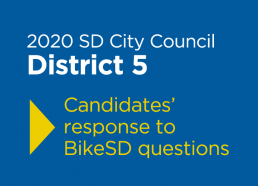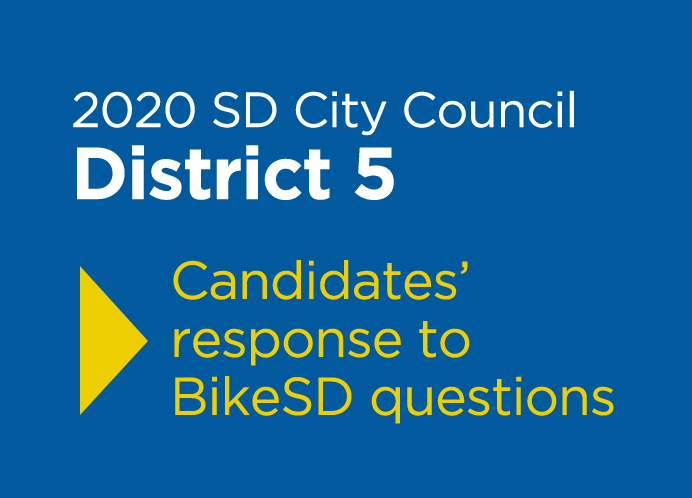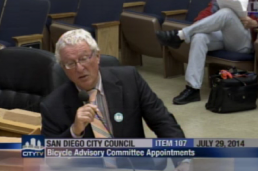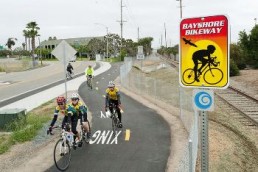2020 City Council Questionnaire - District 5: von Wilpert, Wang
Candidate: Marni von Wilpert —
1) What are your top 3 priorities for improving the biking experience in District 5 for residents and families?
My top 3 priorities to improve the biking experience are (1) building upon the existing infrastructure to increase the amount of dedicated and protected bike lanes, (2) ensuring that our transit hubs have adequate space for bike storage so people can take their bikes to transit centers, and (3) promoting biking as a mode of transportation in addition to a recreational activity.
2) San Diego’s Bicycle Master Plan needs updating and projects need prioritizing in order to create a complete bicycle network. A large number of street resurfacing projects need to be restriped with bicycle infrastructure. How would you propose to fund the full build-out of the bicycle network needed to achieve the Vision Zero goals and meet the Climate Action Plan mode share targets?
I view the bicycle network as a key part of our City’s infrastructure. As a deputy city attorney, I see lawsuits every day that cost our City much more to repair our broken infrastructure than had we invested in the front to properly maintain our streets, sidewalks, and storm drains. When I’m elected, I will prioritize fixing our most vulnerable infrastructure problems first that could subject the City to the greatest liability, so that we save money on unnecessary lawsuits that we can invest in important priorities such as the bicycle network in our City.
3) Transportation is the largest source of San Diego’s greenhouse gas emissions (55%). The City’s Climate Action Plan bicycle mode share goals are 6% of commuter trips by 2020 and 18% by 2035, from about 1% today. What steps will you take to make sure these goals are met or exceeded?
Making sure the City meets its Climate Action Plan goals is one of the main reasons I am running for office. I take the 110 Express Bus to work from Scripps Ranch to downtown, and I see how we can improve service and accessibility for commuters. I will prioritize making sure our City has a world class transportation system, to get cars and trucks off the road and reduce our greenhouse gas emissions.
4) Safe bike lanes often face opposition due to slower road speeds or reduced street parking. How would you work with the community to address concerns without compromising safety or delaying bike infrastructure in the name of consensus?
In many instances, street parking does not need to be reduced to accommodate a protected bike lane, which is a great win-win for motorists and cyclists alike. One of my important campaign priorities is ensuring that people have options for transportation, and that we meet our environmental protection goals. I will work to help educate the community about the importance of alternate transportation options
5) Please share a memorable experience(s) you have of bicycling.
I first learned to ride a bike at Miramar Lake in Scripps Ranch where I grew up. I biked all throughout college at UC Berkeley as my primary mode of transportation, and I didn’t even own a car then. When I worked in Congress in Washington D.C., I commuted on a bike every day using the Capital Bike Share bikes located throughout the district. I highly value biking as a favorite recreational activity, mode of transportation, and just plain fun!
Candidate: Isaac Wang
What are your top 3 priorities for improving the biking experience in District 5 for residents and families?
1. Mobility hubs connected by bus-only lanes (Biking serves as the last mile solution in a sprawled district)
I do believe biking should be the dominant mode of transportation to solve the last mile problem for transit stations (mobility hubs). Given the location of District 5 and it’s distance from our major job centers (La Jolla, Kearny Mesa, and Downtown), I don’t believe biking can be the near term solution for travel to jobs.
I’ll discuss bike superhighways in point #2. But I do think we can reduce most of the 5-10 minute trips (local services, parks, libraries) by switching to bike.
We should be creating Class IV separated bikeways in the minor arterials and collector roads (Class III and Class IV road classifications). Doing this would make traveling to transit stations much more feasible by bike. We also need to ensure bike storage at all transit stations.
With that being said, City Council makes decisions for entire city, not just their own district.
In denser districts like 3 + 9 + 7, we should take away lanes from cars and create much more extensive networks of Class IV bikeways in the arterials and collectors and even the neighborhood roads.
I will unequivocally vote yes on any protected bike lane or separated bikeway, even if it makes the city council member in that respective district unhappy. Don’t expect an urbanist in a blue city council district. Not everyone gets it.
2. Bike Superhighways (aka Bike Freeways)
I believe we need bike superhighways as a major transit priority and in the pipeline of projects.
We’re aware of how long these projects can take, and how terrible CalTrans is.
These projects needed to have been in the pipeline 20 years ago, but here we are.
I’m going to aggressively push for Bike Superhighways like no previous Councilmember ever has.
This doesn’t need any road widening! We need to take lanes away from cars, reallocate them to bicycles, and create physical separators.
These super highways need to connect both mobility hubs + dense residential areas to dense job centers.
In my ideal configuration, bike superhighways (if using highway lanes reallocated from cars) ought to be buffered by a physical barrier and a bus-only lane. Get me as far away from a car as possible.
||||| Travel Lanes ||||| Bus-only Lane ||||| Bike Superhighway |||||
Exit lanes might be a little tricky, but we’d need some bike traffic lights and use of shoulders.
There’s additional places where I’d like to see a ban on cars and a comprehensive bikeway network: Gaslamp, Little Italy, Park Blvd, Liberty Station, Point Loma
3. Creating disincentives for driving
Contrary to many elected officials and candidates who are cautious with their language to not upset drivers, I do believe we need a war on cars.
I’m very vocal about the war on cars. If we don’t reduce GHG emissions, our planet is going to suffer catastrophic consequences. This is scientific consensus.
We need to ensure there is no more free parking. We need congestion pricing. We need to reduce lanes. We need to aggressively shrink the footprint of cement in our cities.
We need an aggressive policy to convert parking lots and roads into something else. I believe the term is “Street Vacations”.
Question 2: San Diego’s Bicycle Master Plan needs updating and projects need prioritizing in order to create a complete bicycle network. A large number of street resurfacing projects need to be restriped with bicycle infrastructure. How would you propose to fund the full build-out of the bicycle network needed to achieve the Vision Zero goals and meet the Climate Action Plan mode share targets?
Answer: Any way possible
Where there’s a will, there’s a way.
If we can find hundreds of millions for a stadium or convention center, we can find a way for anything.
It’s rarely a matter of not enough money, it’s a matter of priorities.
If I can re-divert funds from car infrastructure, I will.
If I have to use money from capital improvement funds.
If I have use money from the gas tax, I will.
If I have to raise taxes through a ballot measure, I will.
If I have to sell lottery tickets to create funds for bicycle infrastructure, I will.
Question 3: Transportation is the largest source of San Diego’s greenhouse gas emissions (55%). The City’s Climate Action Plan bicycle mode share goals are 6% of commuter trips by 2020 and 18% by 2035, from about 1% today. What steps will you take to make sure these goals are met or exceeded?
I think those goals are terrible and underwhelming.
The city with the best weather ought to have 25% cycling within 10 years, and 50% within 20 years.
This is doable, but you have to DESIGN for it and fight for it. I outlined in my top 3 priorities how to do it.
I think every city council staff needs an urban planner / designer on the team.
If you really wanted to increase mode-share, you have to create disincentives for driving as I mentioned in #3 above.
Every able-bodied City or County employee should be required to commute by transit or bike or walking. Or get rid of parking garages for city and county.
That will dramatically increase the sense of urgency to improve infrastructure for cycling and bus.
I will aggressively push for disincentives for driving. And I KNOW you know I will.
4) Safe bike lanes often face opposition due to slower road speeds or reduced street parking. How would you work with the community to address concerns without compromising safety or delaying bike infrastructure in the name of consensus?
We can significantly increase parking in a neighborhood by using angled parking instead of parallel. It gets a road diet in there and automatically serves as a traffic calming measure.
Slower road speeds is the point. I want it slower, because cars kill 30,000 people a year.
If they complain about a loss of parking, pair it with enough angled parking in nearby streets to compensate. If you have to walk a little, deal with it.
We may have to add some drop off zones for disabled folks; that’s always a legitimate concern.
But if you’re able bodied and can walk, you get zero sympathy from me.
Question 5: Please share a memorable experience(s) you have of bicycling.
Vienna, Austria
I rode down a mountain and cycled along a river surrounded by restaurants and public orchestras and people enjoying public spaces.
Do I want America to look like Europe? Hell yes.
There is nothing edifying about designing our cities for cars and having our cities look like cement jungles with gigantic billboards and strip malls.
Cities are best enjoyed and explored by bike. You can see much more than walking, but not have to be in a stupid car.
Urban design is key to all of this. Support a city council member who gets it.
2020 District 5 City Council Questionnaire: Isaac Wang
What are your top 3 priorities for improving the biking experience in District 5 for residents and families?
 1. Mobility hubs connected by bus-only lanes (Biking serves as the last mile solution in a sprawled district)
1. Mobility hubs connected by bus-only lanes (Biking serves as the last mile solution in a sprawled district)
I do believe biking should be the dominant mode of transportation to solve the last mile problem for transit stations (mobility hubs). Given the location of District 5 and it’s distance from our major job centers (La Jolla, Kearny Mesa, and Downtown), I don’t believe biking can be the near term solution for travel to jobs.
I’ll discuss bike superhighways in point #2. But I do think we can reduce most of the 5-10 minute trips (local services, parks, libraries) by switching to bike.
We should be creating Class IV separated bikeways in the minor arterials and collector roads (Class III and Class IV road classifications).
Doing this would make traveling to transit stations much more feasible by bike. We also need to ensure bike storage at all transit stations.
With that being said, City Council makes decisions for entire city, not just their own district.
In denser districts like 3 + 9 + 7, we should take away lanes from cars and create much more extensive networks of Class IV bikeways in the arterials and collectors and even the neighborhood roads.
I will unequivocally vote yes on any protected bike lane or separated bikeway, even if it makes the city council member in that respective district unhappy. Don’t expect an urbanist in a blue city council district. Not everyone gets it.
2. Bike Superhighways (aka Bike Freeways)
I believe we need bike superhighways as a major transit priority and in the pipeline of projects.
We’re aware of how long these projects can take, and how terrible CalTrans is.
These projects needed to have been in the pipeline 20 years ago, but here we are.
I’m going to aggressively push for Bike Superhighways like no previous Councilmember ever has.
This doesn’t need any road widening! We need to take lanes away from cars, reallocate them to bicycles, and create physical separators.
These super highways need to connect both mobility hubs + dense residential areas to dense job centers.
In my ideal configuration, bike superhighways (if using highway lanes reallocated from cars) ought to be buffered by a physical barrier and a bus-only lane. Get me as far away from a car as possible.
||||| Travel Lanes ||||| Bus-only Lane ||||| Bike Superhighway |||||
Exit lanes might be a little tricky, but we’d need some bike traffic lights and use of shoulders.
There’s additional places where I’d like to see a ban on cars and a comprehensive bikeway network: Gaslamp, Little Italy, Park Blvd, Liberty Station, Point Loma
3. Creating disincentives for driving
Contrary to many elected officials and candidates who are cautious with their language to not upset drivers, I do believe we need a war on cars.
I’m very vocal about the war on cars. If we don’t reduce GHG emissions, our planet is going to suffer catastrophic consequences. This is scientific consensus.
We need to ensure there is no more free parking. We need congestion pricing. We need to reduce lanes. We need to aggressively shrink the footprint of cement in our cities.
We need an aggressive policy to convert parking lots and roads into something else. I believe the term is “Street Vacations”.
Question 2: San Diego’s Bicycle Master Plan needs updating and projects need prioritizing in order to create a complete bicycle network. A large number of street resurfacing projects need to be restriped with bicycle infrastructure. How would you propose to fund the full build-out of the bicycle network needed to achieve the Vision Zero goals and meet the Climate Action Plan mode share targets?
Answer: Any way possible
Where there’s a will, there’s a way.
If we can find hundreds of millions for a stadium or convention center, we can find a way for anything.
It’s rarely a matter of not enough money, it’s a matter of priorities.
If I can re-divert funds from car infrastructure, I will.
If I have to use money from capital improvement funds.
If I have use money from the gas tax, I will.
If I have to raise taxes through a ballot measure, I will.
If I have to sell lottery tickets to create funds for bicycle infrastructure, I will.
Question 3: Transportation is the largest source of San Diego’s greenhouse gas emissions (55%). The City’s Climate Action Plan bicycle mode share goals are 6% of commuter trips by 2020 and 18% by 2035, from about 1% today. What steps will you take to make sure these goals are met or exceeded?
I think those goals are terrible and underwhelming.
The city with the best weather ought to have 25% cycling within 10 years, and 50% within 20 years.
This is doable, but you have to DESIGN for it and fight for it. I outlined in my top 3 priorities how to do it.
I think every city council staff needs an urban planner / designer on the team.
If you really wanted to increase mode-share, you have to create disincentives for driving as I mentioned in #3 above.
Every able-bodied City or County employee should be required to commute by transit or bike or walking. Or get rid of parking garages for city and county.
That will dramatically increase the sense of urgency to improve infrastructure for cycling and bus.
I will aggressively push for disincentives for driving. And I KNOW you know I will.
4) Safe bike lanes often face opposition due to slower road speeds or reduced street parking. How would you work with the community to address concerns without compromising safety or delaying bike infrastructure in the name of consensus?
We can significantly increase parking in a neighborhood by using angled parking instead of parallel. It gets a road diet in there and automatically serves as a traffic calming measure.
Slower road speeds is the point. I want it slower, because cars kill 30,000 people a year.
If they complain about a loss of parking, pair it with enough angled parking in nearby streets to compensate. If you have to walk a little, deal with it.
We may have to add some drop off zones for disabled folks; that’s always a legitimate concern.
But if you’re able bodied and can walk, you get zero sympathy from me.
Question 5: Please share a memorable experience(s) you have of bicycling.
Vienna, Austria
I rode down a mountain and cycled along a river surrounded by restaurants and public orchestras and people enjoying public spaces.
Do I want America to look like Europe? Hell yes.
There is nothing edifying about designing our cities for cars and having our cities look like cement jungles with gigantic billboards and strip malls.
Cities are best enjoyed and explored by bike. You can see much more than walking, but not have to be in a stupid car.
Urban design is key to all of this. Support a city council member who gets it.
San Diego City Council Adopts City's First Bicycle Advisory Committee
Earlier this week, on Tuesday, San Diego's City Council unanimously approved the creation of the city's first Bicycle Advisory Committee. This was a goal that was originally proposed in the 2002 city adopted bike plan, the city's second plan to accommodate bicycling.

Getting this committee established was one of our goals for our second year of existence (we launched as an organization in 2012). The composition of the committee calls for each Councilmember adopting one appointee and the two appointees made by the Mayor. Districts 4, 6, and 7 do not have a representative yet, so if you live in these neighborhoods now would be a nice time to get to know your elected representatives at City Council.
The current members of this new advisory committee include the following:
- Petr Krysl, involved with bicycling planning in UCSD where he is also a professor, representing District 1
- Nicole Burgess, who has been asking for improvements on Nimitz for as long as this website has been in existence, representing District 2
- Michael Brennan, the founder of San Diego Streets for People and a board member and a voice of reason at the Uptown Parking District representing District 3
- Kathleen Keehan, former executive director of the San Diego County Bicycle Coalition from 1999 to 2011, representing District 5
- Randy Van Vleck, Active Transportation Manager at the City Heights Community Development Corporation, representing District 9
- Andrew Hanshaw, current executive director of the San Diego County Bicycle Coalition and founder of Bike the Bay, representing District 3
- Kyle Heiskala, who led a successful student fee referendum at UCSD for bus and light rail access representing District 3
- and myself, Samantha Ollinger, representing District 8.
If you're not sure what all the District numbers mean, here is a link to a neat map that visually shows the entire city and its council districts.
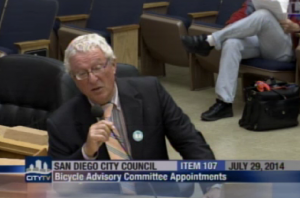
At the Council session on Tuesday, the item to approve the committee was scheduled to be on the consent agenda (essentially voted on without any discussion), however frequent Council Chambers visitor and occasional mayoral candidate, Steven Greenwald, asked for the item to taken out of consent and open for discussion. He was the only member of the public who spoke about the item and he spoke in support of it. He voiced support for "designated bike lanes" and asked that the city look to Vancouver for inspiration. He also talked up bike trains, which Nicole Burgess has been leading in Ocean Beach, and Veronica and Sandra have been leading in Mid-City. Greenwald also mentioned that not all drivers were "sensitive to the fact that bicycles have a place in transportation".
All councilmembers provided positive comments.
Marti Emerald (District 9) stated that perhaps even she could one day be on a bicycle, but that she was "petrified" to ride in traffic today.
Mark Kersey (District 5) thanked Kathy Keehan for her willingness to serve.
Sherri Lightner (District 1) thanked Petr Krysl for his willingness to serve.
Lorie Zapf (District 6 and soon to be District 2) thanked the entire group of committee members and recalled her experience of riding with Burgess and spoke about the needed changes to accommodate the upcoming bike share program as well and changes at Nimitz Boulevard and where the I-8 meets the dog park.
David Alvarez (District 8) spoke about the Climate Action Plan and commended the current District 2 staff that ride to their jobs at City Hall.
Ed Harris (interim Councilmember in District 2) seemed a bit surprised that the issue of bicycling had made a dent at City Hall and made generally positive comments as well.
Scott Sherman (District 7) spoke about the positive effects of seeing more people on bicycles.
Todd Gloria (District 3) stated that this was simply a formalization of the work that all of us had done to date. He also mentioned that the work done in the city to date were "modest" but wanted to see work sped up. Gloria also mentioned that the bike share program was scheduled to launch on October 30th this year. Gloria emphasized that this committee would be working with city staff to advise them on the work that needed to be done.
Emerald made a motion to approve the creation of the Bicycle Advisory Committee and newly re-elected Councilmember of District 2 (to be seated in November) Lorie Zapf seconded the motion.
Driver arrested in Rancho Bernardo hit-and-run crash
The U-T is reporting that the SDPD has arrested a 72-year old woman who crashed into a bicycle rider riding in the bike lane in Rancho Bernardo yesterday afternoon. The driver is suspected of drunken driving.
A dark four-door Hyundai was headed north on Pomerado Road when its driver swerved the sedan into the bike lane, clipping a 62-year-old cyclist near Rancho Bernardo Road about 4:40 p.m., San Diego police officer Dino Delimitros said.
The victim, a woman, suffered a broken spine and ribs. Let's hope this woman receives closure in the form of justice far quicker than it is taking Marjie Barnes-Grant.
$312 million updated Bike Plan passes with unanimous support from City Council

Last Monday, the update to the 2002 Bicycle Master Plan passed with unanimous support from the City Council. This plan to build an additional 595 miles of bicycle facilities nearly doubles the city's existing 510 miles* of facilities and further demonstrated our council's growing commitment to bicycling.
During public comment, two of our proposed requests were included in the motion made by Council Member (and current mayoral candidate) David Alvarez and amended by Council Member Sherri Lightner. Our request to create a Bicycle Advisory Committee to ensure the implementation of the plan was also supported by the San Diego County Bicycle Coalition (SDCBC). Our request to remove the Coastal Rail Trail alignments from Rose and Roselle Canyons was not supported by the SDCBC but was supported by the community that this alignment affected: the Friends of Rose Canyon, the University Community Planning Group and Council Member Lightner whose district includes University City. Council Member Lightner spoke to not only preserving the city's limited remaining open space but to also saving the city the huge financial and environmental expenses of building in Rose and Roselle Canyons - an amendment that was accepted by Alvarez and the rest of the council.

Melissa Garcia, Senior Planner at the City of San Diego, presented the item for council consideration by stating that the goal of the plan was to "create a city where bicycling is a choice." The goal to promote "environmental quality, public health and recreation and mobility benefits" were also mentioned. The purpose of the plan, Garcia stated, was to "maximize spending choices for implementation."
The original Bicycle Master Plan was adopted by the City Council over a decade ago in 2002. The update to the 2002 Bicycle Master Plan was prepared by Alta Planning + Design for the City of San Diego and begins with this promising statement in its introduction:
"...the updated plan provides direction for expanding the existing bikeway network, connecting gaps, addressing constrained areas, improving intersections, providing for greater local and regional connectivity, and encouraging more residents to bicycle more often."
Since 2002, most of the facilities built have been incredible and award-winning (such as the bike path around Lake Murray and Miramar Reservoir), but not effective in meeting the needs of everyday San Diegans by connecting neighborhoods to ensure daily riding in a way that is safe and comfortable. In the two years since the plan was updated, the plan went through respectable community feedback and input. Is the plan the best that it can be for current and future riders? The plan is incredibly promising and it should give everyone cause to celebrate. But a good plan alone will not transform our city. The important lesson from the last Monday's vote is that the political will is unanimous and the way forward is to ensure that this plan actually gets implemented with the efforts of a Bicycle Advisory Committee.

What will this committee do and who will it be composed of? That depends on what the City Attorney proposes to the City Council, but we'd like to have council staff, city staff, advocates and community members (including high school and college students) be active representatives. This committee will ensure that facilities get built and that the group doesn't become yet another layer of bureaucracy inhibiting the implementation of the bicycle plan. We'd like to see all facilities implemented with complete transparency.
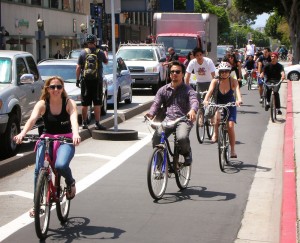
In this year alone, our council members have demonstrated incredible leadership. Interim Mayor Todd Gloria was the first to lead on the issue. Gloria has been very receptive to feedback, ideas, and has demonstrated a willingness to lead in a way that has not been seen before in San Diego. Council member and Land Use and Housing Chair Lorie Zapf's Council Resolution has provided us with much needed leverage to ensure accountability from the city staff in implementing bicycle infrastructure in the city. We have also learned how to listen to communities (such as the Friends of Rose Canyon) that seek us out and explain their concerns. Our success in transforming this city into a world-class city for bicycling depends on meeting the needs of our current ridership and being open and receptive to the feedback we receive from potential riders.
The next steps are not only to create the Bicycle Advisory Committee, but also to ensure that the plan is implemented. How will that happen? That will be the work for BikeSD's second year. Thank you for joining us on the ride.

---

